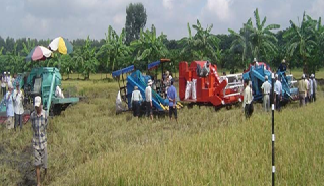 Development of rice combines in Viet Nam#
Development of rice combines in Viet Nam#
Phan Hieu Hien, Tran Van Khanh# # , Graeme R. Quick ***
E-mail: phhien@hcm.vnn.vn
# Paper for presentation at the International Conference on Crop Harvesting and Processing, February 11-14 2007, Louisville, Kentucky.
# # Lecturers, Nong-Lam University (formerly: University of Agriculture and Forestry), Ho- Chi-Minh City, Viet Nam,
*** Consulting Engineer (Queensland, Australia) and Former Head, IRRI Agricultural Engineering, Philippines.
ABSTRACT
Rice combine development in Viet Nam, especially in the Mekong Delta in the South, has been a slow process. Mechanized farm equipment is accepted only if it matches local agricultural conditions technically and economically. Earlier attempts at bringing in or developing combines by Central research institutes, Provincial factories, and farmer-mechanics were unsuccessful at actual scale operation. Three main problems were encountered over the past 20 years:
(1) Machines working in soft paddy fields bog down, especially heavy Western-style combines.
(2) Reliability at lowest cost is critical; delays caused by machine breakdowns result in significant lost income during the harvest, and unreliability discourages users from adopting new technology.
(3) Harvesting severely lodged rice crops is challenging, not so much as an engineering problem as it is a matter of plant breeding and varietal selection to improve lodging resistance.
Nevertheless there has been intensive development in the past 5 years by as many as 15 small- scale Vietnamese manufacturers. One mini-combine manufacturers has lately sold 90 units to private farmers across the country. In 2006 a combine contest was organized by the Vietnamese National Testing Agency. Three designs were given “accredited recognition awards”, meaning recognition for future promotion through the governmental Extension system. The recent development of mini-combines follows.
Keywords: Combine, Rice Harvesting, Mechanization
INTRODUCTION
Viet Nam is an agricultural country with 82 millions (M) inhabitants in 2005, of which 61 M are in rural households. Rice is the most important crop, cultivated on 80 % of the total farm area, and rice accounts for 85 % of the country’s food grain output. In 2003 , Viet Nam produced 35 M ton of paddy on 4.2 M ha of rice land. This total production was four times more than that of 1976. Viet Nam is the world’s third largest rice exporter. For the past 10 years, the export of rice has been 3 – 4 M tonnes a year.
The Mekong Delta in Southern Viet Nam , with 2.7 M ha of rice land, is producing about 50 % of Viet Nam total rice output. With only 17 % of the total population, this region has accounted for more than 90 % of Vietnamese rice export in the past decade. Average farm size is about 1 ha per household, although in some newly-reclaimed districts, 3 - 10 ha per household is not uncommon.
Rice harvesting in the Mekong Delta of Viet Nam is still mostly done manually, but threshing was completely mechanized. Over the past 20 years, effort to introduce rice harvest equipment in this region have been attempted by different government agencies as well as the private sector, from central research institutes to skilled village mechanics. Different alternatives have been tried, i.e. the reaper or the combine, but these either failed or were only half-way solutions to the problem.
This paper describes the slow process of combine development in the Mekong Delta, identifies affecting factors and related problems. Details of the work on a mini-combine, including wheel systems for wet soils, and promotion to the industry for manufacturing are presented.
Số lần xem trang: 3721

